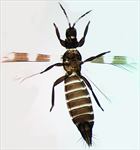
Female

Antenna

Antennal segments III–IV (phase contrast image)
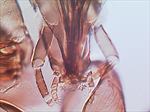
Maxillary and labial palps
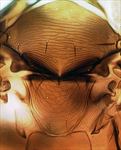
Mesonotum & metanotum
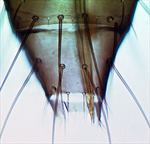
Tergite X with pair of small trichobothria

Thoracic sternites
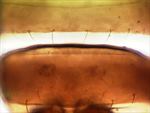
Female abdominal sternites VI–VII
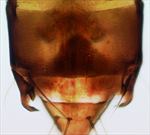
Male tergite IX

Fore wing
Both sexes with banded wings; median pale band shorter than distal dark band. Body and legs brown, antennal segment III yellow with only extreme apex dark. Antennae 9-segmented, segment III long and slender with linear sensorium scarcely 0.3 as long as segment, IV with sensorium almost 0.5 as long as segment and curved distally; segments V–IX forming a single unit with V about the same length as VI–IX. Head and pronotum with no long setae. Fore tarsus apically with stout recurved ventral hamus. Abdominal tergite X with pair of very small trichobothria. Marginal setae on sternites arising at or close to margin; sternite VII with two pairs of accessory setae arising well in front of margin.
Male tergites IV and V sometimes with very small paired dorsal tubercles; setae at base of bifurcate claspers on tergite IX much longer than clasper, with no stout curved seta lateral to clasper; antennal segment III almost fuscous rather than yellow, but abdominal segments III–V sometimes paler than II and VI.
The complex of species related to A. fasciatus, including some from California such as A. duvali, requires considerable further study. Because of the similarity amongst females of these species, only males can currently be identified as fasciatus with confidence. About 105 species are placed currently in the genus Aeolothrips. Most of these are from the Palaearctic Region (including the Mediterranean, Iran and northern India, but with five species extending through eastern Africa to South Africa), with about 30 species from the Nearctic (mainly western USA). Only one species of this genus is known from the Neotropics; although common in Chile, A. fasciatipennis Blanchard is known only from females. Mound & Marullo (1996) indicate this species is probably the same as A. fasciatus.
Found in the flowers of a range of plants, with no recorded specificity, but probably a facultative predator with a mixed diet of pollen and the larvae of other thrips.
Probably originally from Europe, females identified as this species have been recorded widely around the world. In contrast, males have been studied only from Finland, Denmark, Slovakia, Azores, Hokkaido, New Zealand and Tasmania. Some of the published records that are based only on females are probably misidentifications of A. intermedius Bagnall, a common species in northern Europe that has a rather shorter third antennal segment. Moreover, some of the North American records are possibly misidentifications of the brown morph of A. auricestus. Currently, if males are not available, it is probably not possible to identify species confidently in this group. From both New Zealand and Tasmania (Australia) males and females have been studied that cannot be distinguished from European specimens of A. fasciatus. Females from Chile to which the name A. fasciatipennis has been applied cannot be distinguished from A. fasciatus females, but no males of this group have been seen from South America.
AEOLOTHRIPIDAE
Aeolothrips fasciatus (Linnaeus)
Thrips fasciatus Linnaeus, 1758: 266
Coleothrips trifasciatus Fitch, 1855: 386
Aeolothrips atricornis Maltbaek, 1927: 14
Aeolothrips justiciae Post, 1961: 137
Alavi J & Minaei K. (2018) Studies on the genus Aeolothrips (Thysanoptera: Aeolothripidae) in Iran, with a key to species. Zootaxa 4446 (3): 343–360.
Mound LA & Marullo R (1996) The Thrips of Central and South America: An Introduction. Memoirs on Entomology, International 6: 1–488.
Mound LA, Nielsen M & Hastings A (2017) Thysanoptera Aotearoa - Thrips of New Zealand. Lucidcentral.org, Identic Pty Ltd, Queensland, Australia.
http://keys.lucidcentral.org/keys/v3/nz_thrips/index.html
zur Strassen R (2003) Die terebranten Thysanopteren Europas und des Mittelmeer-Gebietes. Die Tierwelt Deutschlands 74: 1–271.